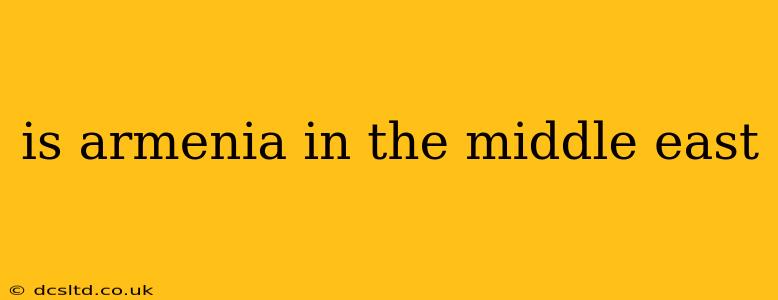Is Armenia in the Middle East? A Geographic and Cultural Perspective
The question of whether Armenia is in the Middle East is complex, defying a simple yes or no answer. It depends on how you define "Middle East," a term itself fraught with ambiguity and often reflecting political and historical biases rather than strict geographical boundaries.
Geographical Considerations:
Geographically, Armenia sits at the crossroads of Western Asia and Eastern Europe. It's located on the Armenian Highland, a mountainous region bordering Turkey to the west, Georgia to the north, Azerbaijan to the east, and Iran to the south. This location places it within the broader region often referred to as Western Asia. However, many definitions of the Middle East exclude the Caucasus region, placing Armenia outside the commonly understood boundaries.
Cultural Influences:
Armenia's cultural landscape is rich and diverse, reflecting its unique history and position at the intersection of various civilizations. While it shares some cultural traits with Middle Eastern nations, particularly its neighbors like Iran, its own distinct identity is firmly rooted in its ancient history and Christian heritage, setting it apart from many predominantly Islamic Middle Eastern countries. This cultural distinction is a key factor in understanding why its inclusion in the Middle East is debated.
Frequently Asked Questions (FAQs)
Here are some common questions related to Armenia's geographic location and its relation to the Middle East:
What region is Armenia considered part of?
Armenia is often categorized as part of the Caucasus region, a geographic area encompassing Armenia, Azerbaijan, and Georgia. Depending on the context, it may also be included in broader classifications like Eurasia or Western Asia.
Is Armenia in Asia or Europe?
This is another point of debate. Geographically, Armenia lies in Western Asia. However, culturally and historically, it has strong ties to Europe, resulting in occasional inclusion in discussions of Eastern Europe. The reality is that it transcends simple categorization.
What are the cultural similarities and differences between Armenia and Middle Eastern countries?
Armenia shares some historical and cultural overlaps with Middle Eastern countries, particularly in terms of trade and religious interaction, especially with Iran. However, Armenia's predominantly Christian faith and unique cultural traditions create significant distinctions from many predominantly Muslim Middle Eastern nations.
Why is the definition of "Middle East" so ambiguous?
The term "Middle East" is largely a Western construct, developed during the colonial era. Its boundaries have shifted over time, often reflecting geopolitical interests rather than strict geographical or cultural criteria. This ambiguity contributes to the ongoing debate about Armenia's inclusion.
Conclusion:
Ultimately, whether or not Armenia is considered part of the Middle East depends heavily on the definition used. While its geographical location places it in Western Asia, its unique cultural and historical identity sets it apart from many other regions typically associated with the term "Middle East." Understanding this nuance is key to avoiding oversimplification and appreciating the complexity of regional geography and culture.
